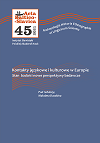Intertekst Wilna w twórczości Vaidotasa Daunysa
The Intertext of Vilnius in the Works of Vaidotas Daunys
Author(s): Małgorzata KasnerSubject(s): Christian Theology and Religion, Studies of Literature, Lithuanian Literature, Existentialism, Biblical studies
Published by: Instytut Slawistyki Polskiej Akademii Nauk
Keywords: Lithuanian literature; Vaidotas Daunys; Vilnius; intertextuality; intertext of Vilnius; Christian philosophy; existential philosophy; the Bible;
Summary/Abstract: The aim of the present article is to analyse the intertext of Vilnius in the works of the Lithuanian poet, essayist and editor Vaidotas Daunys (1958–1995) by drawing on the categories of intertextuality and intertext (J. Kristeva, R. Barthes, M. Riffaterre, M. Głowiński, S. Balbus, R. Nycz). In Daunys’ poems and essays, the reader perceives Vilnius as a mental construct, multilayered structure of meaning or a complex metaphor referring to a specific place on the map of north-eastern Europe, the political centre of the independent Republic of Lithuania since 1990. His debut collection Metų laikai [The Four Seasons, 1985] containing his early lyrics deals with urban themes, which will also become one of the recurrent motifs in his essays. This collection introduces themes, metaphors and symbols developed and recreated by the author over the following decades: the city of myth, the city of nature, the city of faith. In his poetry, Daunys illustrates how the personal and psychological city (the individualized place of the lyrical subject, where the history takes place here and now) evolves into the meta-city and philosophy of the city (Vilnius as a timeless and sacred city, with strong communal bonds). Daunys was a gifted observer, therefore, in his works (and artistic activities), at the aesthetic, ethical, philosophical and theological levels, he consequently and skilfully presented Vilnius as the central place of his homeland where multiple voices can be heard, as the Baltic cradle of Lithuanian culture and the home to many languages, cultures and nations. His source of inspiration was Lithuanian and European cultures (mainly literature oscillating between existential and ontological questions; Christian and existential philosophy; but also history, music, architecture and photography), based on the solid Christian foundation (the Bible). Translated into the language of the modern city and experience of the watershed years, these sources, displaying various forms of intertextuality, have created a multilayered web of meanings that Vilnius entails.
Journal: Acta Baltico Slavica
- Issue Year: 2021
- Issue No: 45
- Page Range: 1-21
- Page Count: 21
- Language: Polish

